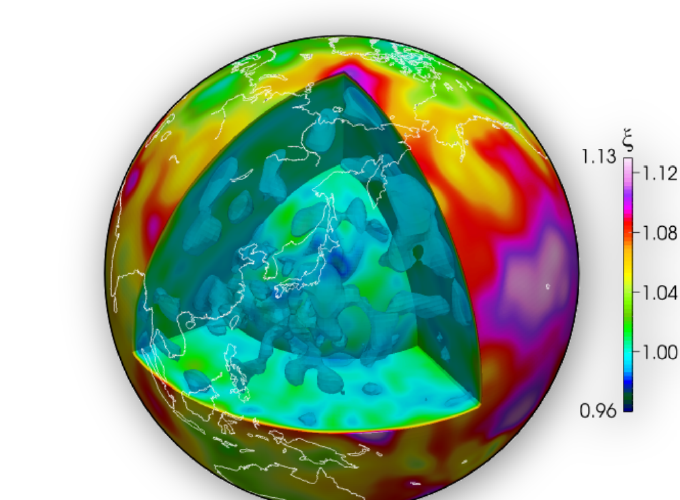Global anisotropy (SAVANI)
Together with colleagues at UPMC Paris (Lapo Boschi), USC Los Angeles (Thorsten Becker) and University of Oxford (Tarje Nissen-Meyer), have developed a new global model of anisotropic shear-velocity variations, called SAVANI, which represents one of the first attempts to map anisotropic wavespeeds at the scale of the entire mantle. While being well correlated with earlier models at long spatial wavelength, our preferred solution, savani, additionally delineates a number of previously unidentified structures, due to its improved resolution in areas of dense coverage.
This is because the density of the inverse grid ranges between 1.25° in well sampled to 5° in poorly sampled regions, allowing us to resolve regional structure better than it is typically the case in global S-wave tomography. Important features of our model include: (i) A distinct ocean-continent anisotropic signature in the uppermost mantle; (ii) an oceanic peak in above average ξ > 1 which is shallower than in previous models and thus in better agreement with estimates of lithosphere thickness.

You can find more details about SAVANI and its construction in Auer et al. 2014. Also, feel free to download our model and documentation from my GitHub, if you want to use the model for your own work.
Oceanic upper mantle
Defining the oceanic lithosphere as a thermal boundary layer allows to explain, to first order, age-dependent bathymetry and isotropic wavespeeds. In contrast, SS precursors and receiver functions suggest a subhorizontal interface within this layer, on top of a radially anisotropic zone. Comparing a suite of geodynamic scenarios against surface-wave dispersion data and seismic discontinuties we find that only weak age dependency of the radially anisotropic zone is compatible with observations. We show that this zone is confined from below by a second, weaker seismic interface.

While azimuthal anisotropy is consistent with LPO of olivine due to asthenospheric flow underneath the lithosphere, radial anisotropy requires additional contributions, perhaps from petrological fabrics or melt ponding. This implies that seismic reflectors previously associated with the base of the lithosphere are instead associated with preserved structures embedded in it. They carry information about plate formation, but have little control on plate deformation. See Auer et al. 2015.
Software for global tomography
During my PhD I developed and contributed to several tools for global tomographic imaging, some of which are publicly available. See:
PETScinv - A general purpose parallel tomography solver based on PETSc
PETScinv is a modular, general purpose tomography solver written in (object oriented) Fortran 2008. PETScinv solves global tomographic imaging problems in parallel using the PETSc component KSP. The scalable linear equations solvers (KSP) module provides an easy-to-use interface to the combination of a Krylov subspace iterative method and a preconditioner (in the KSP and PC components, respectively) or a sequential direct solver.
The code currently only supports orthogonal, curvilinear hexahedral basis functions (spherical sections or voxels), but adding modules to treat other parametization strategies (splines, spherical harmonics, wavelets) to discretize the model space, should be straightforward. One can account for different regularization approaches, such as roughness minimization or norm minimization. Tomography results can be exported in a simple ASCII format or as netcdf files, together with an .xdmf file, ready to be explored with ParaView. Get the code via my GitHub.
FLEXinv - Ray-theoretical surface and body wave sensitivity kernels
Flexinv is a Fortran/Python toolbox to create global, adaptive resolution
transversely isotropic tomographic models of the entire mantle, via joint
inversion of surface-wave dispersion and body-wave traveltimes, in the
high-frequency ray approximation. See
Some components of the surface wave parts of this code go back to Woodhouse (1981) and Dziewonski & Anderson (1981). The body-wave routines go back to Gu (2005). Crustal corrections are based on CRUST2.0 by Laske et al. (2002). Models are parameterized in curvilinear hexahedrons, whose size is adapted to local ray coverage, following Schäfer et al. (2011). Get the code via my GitHub.
MCkernel - Broadband waveform sensitivity kernels for seismic tomography
MCkernel is a software implementation to calculate seismic sensitivity kernels on arbitrary tetrahedral or hexahedral grids across the whole observable seismic frequency band. These kernels rely on wavefield databases computed via AxiSEM (www.axisem.info), and thus on spherically symmetric models. The advantage is that frequencies up to 0.2 Hz and higher can be accessed.
Since the usage of irregular, adapted grids is an integral part of regularisation in seismic tomography, MCkernel works in a inversion-grid-centred fashion: A Monte-Carlo integration method is used to project the kernel onto each basis function, which allows to control the desired precision of the kernel estimation.
Also, it means that the code concentrates calculation effort on regions of interest without prior assumptions on the kernel shape. The code makes extensive use of redundancies in calculating kernels for different receivers or frequency-pass-bands for one earthquake, to facilitate its usage in large-scale global seismic tomography. MCkernel is available here

